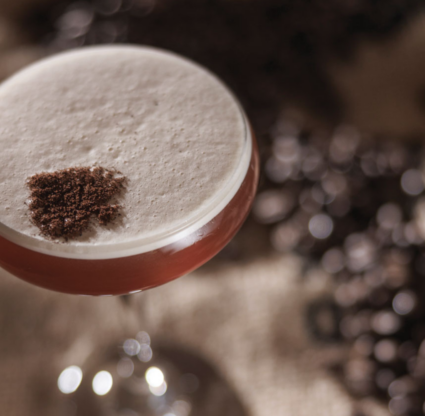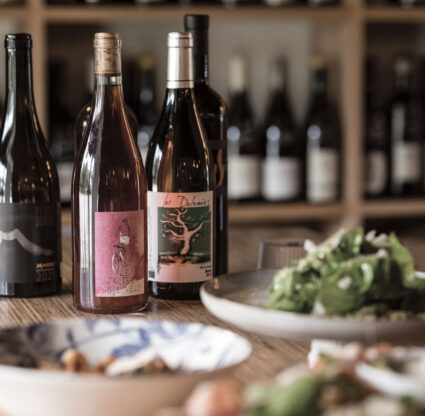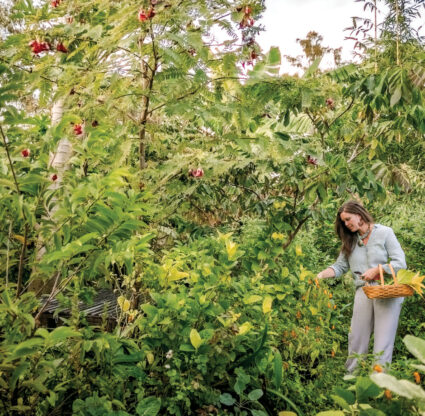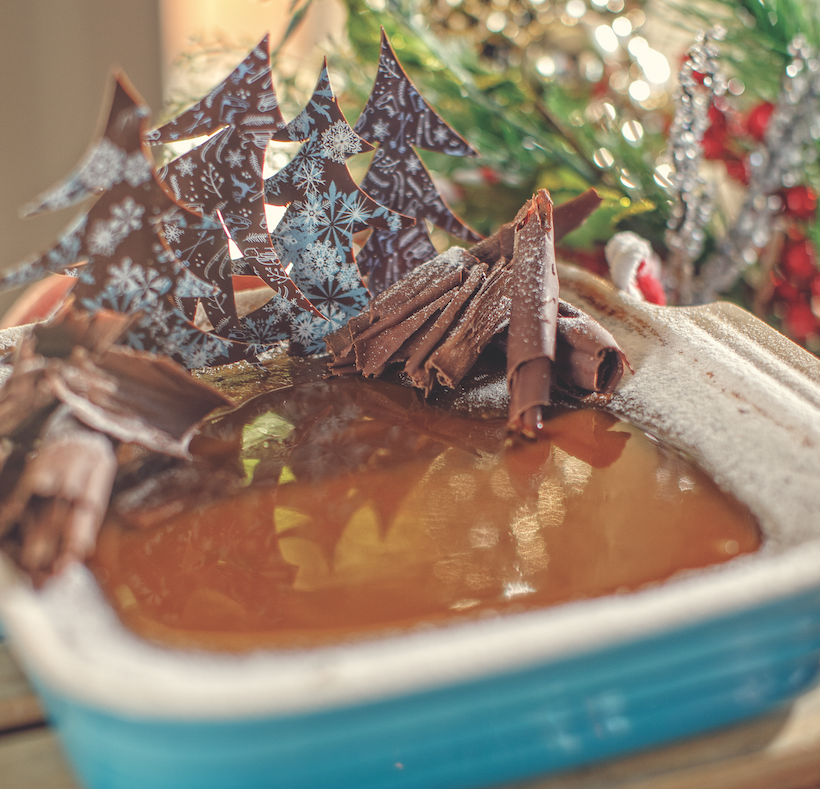
English Sticky Toffee Pudding From Lerome Campbell at The Ritz-Carlton, Naples
Lerome Campbell found redemption through sticky toffee pudding. The Ritz-Carlton, Naples’ executive pastry chef had made it to the Food Network’s “Holiday Baking Championship” in 2018, but got eliminated in the last of seven rounds. Then, in 2019, the network debuted a redemption round titled “Holiday Baking Championship Sweet Revenge,” starring the runners-up from the previous three years. Campbell won with his sticky toffee pudding.
The finalists drew one of the three celebrity chef judges’ favorite holiday dishes. Campbell lucked out with Lorraine Pascale’s pick for sticky toffee pudding. “I was overjoyed,’” he says. “I knew my experience making it with Peter Timmins over the years would come in handy.”
Although Campbell hails from Jamaica, once a British colony, he didn’t grow up with the gooey treat Pascale remembered from her youth in London. However, Timmins, a master chef, had taught Campbell the recipe back when he worked at the esteemed Gasparilla Inn in Boca Grande. The chef has introduced it for the holidays in every kitchen he has worked since then, including Naples’ two The Ritz-Carlton locations.
Regarding his own traditions, Campbell recalls the rum fruitcake he learned to bake in his mother’s bakery in Jamaica. “There were five of us, four girls,” he tells. “During the holidays, I was the only one in the kitchen with her.” The two still make rum fruitcakes come December. “Although she’s retired, she still bakes a better Christmas cake than me,” he concedes.
He, no doubt, has her bested in the sticky pudding department. Campbell advises using hazelnut flour. Whiskey is another secret, and he cooks the sauce into the pudding at the end, rather than just pouring it over the top when serving.
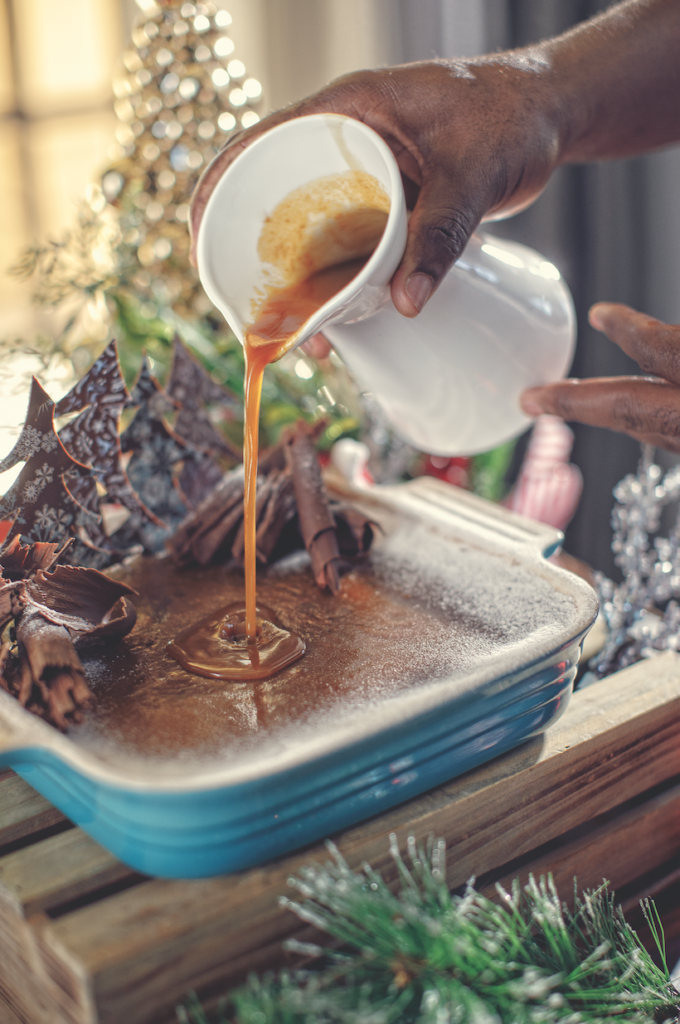 CAMPBELL’S STICKY TOFFEE PUDDING
CAMPBELL’S STICKY TOFFEE PUDDING
Makes: 10 servings
For the cake:
- 4 cups pitted dates
- 8 cups water
- 3 cups all-purpose flour
- 1½ tablespoons baking powder
- 1 tablespoon baking soda
- ½ cup hazelnut flour
- ¾ cup butter
- 2 cups dark brown sugar
- 1 vanilla bean
- 2 whole eggs
- 1 egg yolk
- ¼ cup maple syrup
- ¼ cup molasses
- 1 tablespoon caramel color
- Zest of 1 orange
For the sauce:
- 2 cups cream
- ½ cup sugar
- 1/3 cup cold butter, cubed
- 1½ cups whiskey
- 2½ cups dark brown sugar
- 1 vanilla bean
 To make the cake:
To make the cake:
- Heat the oven to 325 F.
- Boil the dates in water for 10 minutes on medium heat. Allow to cool and puree in a Vitamix or food processor. Set aside.
- Sift dry ingredients (except brown sugar) together and set aside.
- Cream butter and half the dark brown sugar. Combine eggs and egg yolk; scrape vanilla bean into eggs. Slowly add the eggs to the sugar mixture, then add the rest of the sugar.
- Add the dry ingredients.
- Slightly warm maple syrup, molasses and caramel color, then add to cream mixture.
- Pour into a 12-inch-by-2½-inch casserole dish. Bake for about one hour. Stick a knife in the center of the cake. When the knife comes out clean, the dish is done. While baking, prepare the sauce (recipe below).
- Remove cake from oven; pour sauce on top and pierce the cake all over to let the sauce soak in. Wrap with plastic film, and place back in the oven to steam for about 10 minutes.
To make the sauce: Bring cream to a low boil and set aside.
- In a separate saucepan, make a dry caramel by stirring the sugar constantly at medium heat. When the caramel reaches a nice amber color, slowly add in the cubes of butter. To deglaze, slowly stir in whiskey. Add brown sugar and deglaze with the hot cream.
- Add vanilla bean and stir until sugar dissolves. Remove vanilla bean.
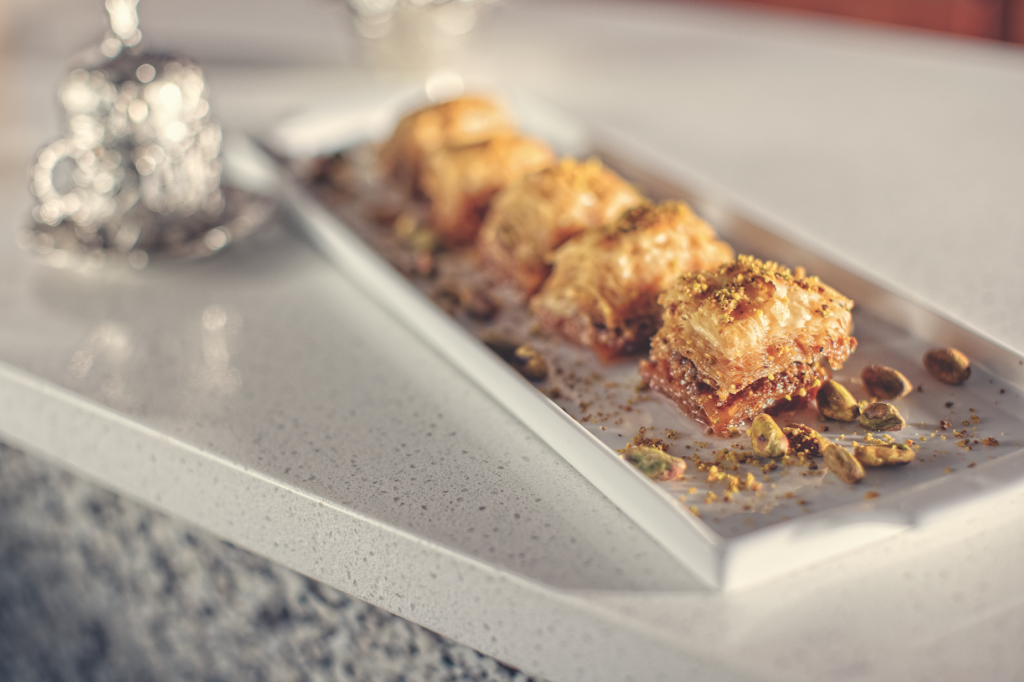
Turkish Baklava from Burak Çakir at Ephesus Mediterranean Grill, Port Charlotte
There is a saying in Turkey: “I’m not rich enough to eat baklava every day.” Burak Çakir, who grew up near Ephesus in modern-day Turkey, explains that in the 1400s, during the Ottoman Empire, sultans feasted on the sweet, flaky treat, and until the 19th century, only the rich could afford it.
Today, the Ephesus Mediterranean Grill chef and owner makes the labor-intensive, layered confection fresh every day in his Port Charlotte restaurant. But in Turkish households, it’s reserved for special occasions like weddings and religious holidays.
Baklava is one of those shared dishes between Greece, Lebanon, Israel and other countries once under the Ottomans. But Çakir puts the Turkish trademark on his by using pistachios imported from his homeland, rather than the more typical walnuts.
Çakir, who first came to the area when the Gasparilla Inn recruited him to help in the kitchen when he was 17, learned to make baklava watching his mom and elders in the neighborhood. “Then I started working in professional kitchens to perfect each and every layer,” Çakir says. “Baklava has around 220 layers of phyllo dough and each layer has been buttered. We put love into each layer.”
Though it’s an involved recipe, your effort will yield a big batch, good for sharing with friends. Although Çakir makes his own phyllo dough, he advises beginners buy prepackaged product and serve the baklava at room temperature.
If you’re craving the real thing, it’s worth the trip to Port Charlotte, where Çakir runs his restaurant with wife, Michelle. This season, the two debuted a bakery adjacent to their ornate Turkish-inspired restaurant. Naturally, it will feature baklava in its many variations, including chocolate.
 ÇAKIR’S BAKLAVA
ÇAKIR’S BAKLAVA
Makes: 45 squares
For the dough:
- 2 20-sheet packs phyllo dough (thawed and at room temperature)
- 2½ sticks butter, melted
- 2 to 3 cups salted pistachios (or walnuts), chopped finely or pulsed in food processor
For the syrup:
- 3 cups sugar
- 5 cups water
- 1 lemon wedge
To make the pastry:
- Heat oven to 350 F.
- Butter a half-sheet baking pan (18 by 13 inches) and set aside.
- Trim phyllo sheets to pan size. Keep covered with damp towel.
- Layer five phyllo sheets in pan, brushing each layer, except for the top one, with melted butter. Spread 2 tablespoons of nuts on top layer. Repeat until all phyllo sheets are used, then butter top layer. Cut into squares or diamonds and bake until golden, about 45 minutes. (Note: If the crust isn’t golden brown before pouring on the syrup, the baklava may become mushy.)
- Remove baklava from oven and pour cooled syrup on top. Let sit at room temperature at least four hours, or overnight.
To make the syrup:
- Dissolve sugar in boiling water over medium-high heat. Add lemon wedge, to prevent sugar from crystallizing, and cook syrup for 15 to 20 minutes on low. Let cool while preparing phyllo. Remove lemon wedge.

Italian Cuccidati from Anne Marie Peterson at DeRomo’s Gourmet Market, Bonita Springs
Although she remembers vanilla spritzes and walnut snowballs growing up in Connecticut in a home with northern European roots, Ann Marie Peterson now cannot imagine Christmas without cuccidati, a traditional Italian fig cookie. Think a Newton, but way juicier, more cakey and swaddled by the care of hours in the kitchen.

Since Peterson joined the staff at DeRomo’s Gourmet Market in 2016, she’s come to love the cookies as if she’d grown up with them. Most of the customers who order them, she says, remember them from Italian bakeries in Brooklyn. They place their orders in advance, knowing that Peterson will make only two batches in the weeks before Christmas. And when they’re gone, forget about it!
The recipe dates back hundreds of years to Sicily and southern Italy, where an Arab influence introduced figs, raisins and other dried fruits. Kids love them, Peterson says, because of the nonpareils that decorate the outer dough. She uses festive gold, burgundy and other holiday colors for DeRomo’s. “The kids think they’ve died and gone to heaven,” she says.
The secret for home cooks to achieve her soft cookie dough with a crunchy edge: Make sure it’s cold before rolling it out. Though Peterson learned the art of cuccidati at DeRomo’s, she has been training as a pastry chef since her schooling at the Connecticut Culinary Institute, where she picked up plenty of trade secrets.
Since moving to Florida 23 years ago, she has ruled the ovens of Roy’s Restaurant and Cielo on Sanibel Island. “I liked the market at DeRomo’s–it has that old-fashioned bakery style, and I thought it would be an opportunity for more diversity,” she says. Her annual encounter with making up to 70 pounds of cuccidati each year has cemented her beliefs—and her Italian sweet tooth.

PETERSON’S CUCCIDATI
Makes: 2 dozen cookies
For the filling:
- 1 pound dried figs, soaked in 2 cups warm water for 10 minutes, thoroughly drained
- ½ cup chopped walnuts
- ¼ cup slivered almonds
- 1 cup raisins
- ¼ cup mini-chocolate chips
- ¼ cup mixed candied fruit
- ¾ teaspoon cinnamon
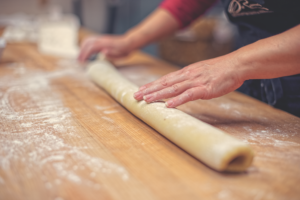 For the dough:
For the dough:
- 2¼ cups all-purpose flour, plus more for dusting
- ½ cup sugar
- teaspoon salt
- 1¾ sticks cold unsalted butter, cut into small pieces
- 1 large egg, lightly beaten
- 1 large egg yolk, lightly beaten
- 1 teaspoon pure vanilla extract
- 1 tablespoon freshly grated lemon zest
- 1 large egg, beaten with 1 teaspoon water for egg wash
To make the filling:
- Pat figs dry with a paper towel and place in food processor. Pulse until finely chopped. Add remaining filling ingredients and pulse until all is finely chopped. Set aside.
To make the dough:
- Heat oven to 350 F.
- In a food processor, pulse flour, sugar and salt just until combined. Add butter; pulse until mixture resembles coarse meal, six to eight times.
- In a separate bowl, whisk together egg, yolk, vanilla and lemon zest. With processor running, add egg mixture to butter mixture; process just until dough begins to come together. Turn dough out onto a floured work surface; lightly knead to form a ball.
- Divide dough into two, and gently press each into flat disks. Wrap tightly in plastic wrap. Refrigerate at least 1 hour, or overnight.
- Roll out half of one portion of dough into a rectangle ¼ inch thick. Place 1 cup of the fig filling in a strip along one long side of the dough and roll up, completely encasing the filling.
- Cut the log into 2-inch pieces and place on a parchment lined baking sheet. Brush each with egg wash and sprinkle with nonpareils.
- Bake for about 12 minutes, until deeply golden.
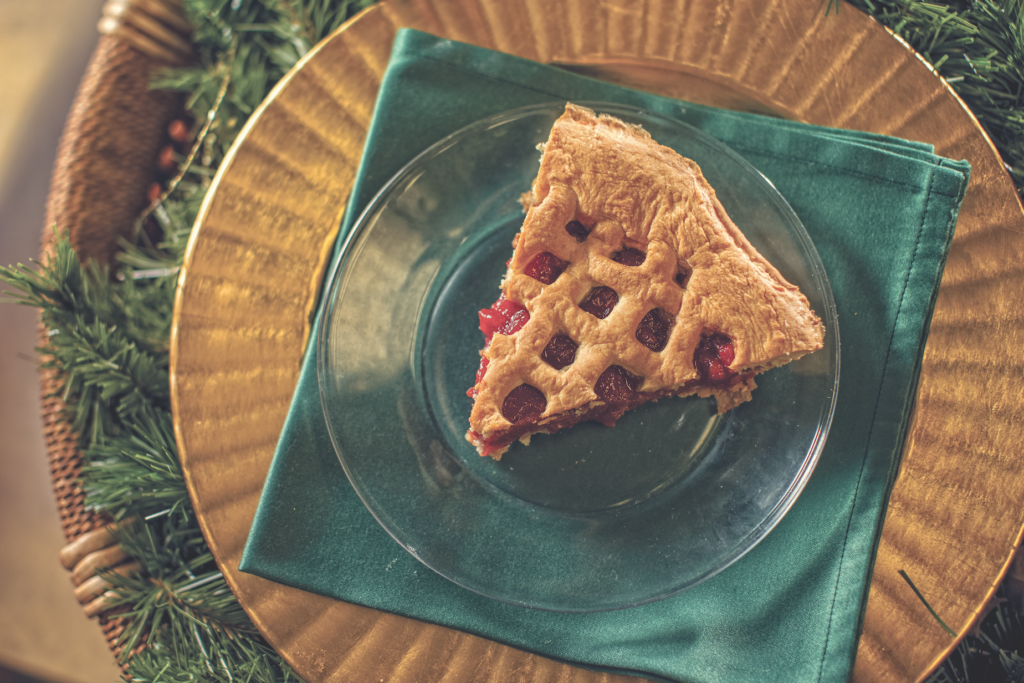
Virgin Islands Tart from Clifford Parris at Tony’s Off Third, Naples
One of Clifford Parris’ earliest memories of guava tart was sniffing the spicy crust as he worked with his late grandmother at her bakery on the island of Tortola in the British Virgin Islands. At age 11, he was already helping her during the holidays, when the orders for coconut and guava tarts poured in. “She would always call on me to bake for Christmas, which was her busiest time,” Parris, head baker at Tony’s Off Third in Naples, says. “She had 11 grandkids, and I was the only one she’d call.”
 His grandfather would shell coconuts straight off the tree, and his grandmother would thaw the filling she had frozen especially for holiday tarts during summer’s guava season. But where Parris is concerned, it’s all about the crust. “The dough is spiced, and the mixing method is so different,” he says, adding that like his grandmother, whose family business his aunt has taken over, he gently folds in the liquids, lending it a unique texture more like a scone with crispy edges.
His grandfather would shell coconuts straight off the tree, and his grandmother would thaw the filling she had frozen especially for holiday tarts during summer’s guava season. But where Parris is concerned, it’s all about the crust. “The dough is spiced, and the mixing method is so different,” he says, adding that like his grandmother, whose family business his aunt has taken over, he gently folds in the liquids, lending it a unique texture more like a scone with crispy edges.
Those bakery memories changed the course of the chef’s life, which was headed scholastically toward accounting. Remembering how happy baking made him, he attended a branch of the New England Culinary Institute in Tortola. His first internship took him to Florida at age 17, and after baking gigs with Marriott resorts in Fort Lauderdale and Marco Island, he landed at Tony’s in 2014.
Tony’s cuts and hand-frosts nearly 500 gingerbread men and sugar cookies each December, but Parris’ tarts are not on the menu. He never fails to make them every holiday, however, for his wife Keshia, who favors guava; his 6-year-old son Cekai, who likes just the dough; and his 2-year-old son Caeden, who “eats anything.” Parris prefers coconut and also makes pineapple tarts.
For Parris, the tarts bring back memories of holidays at home, where Christmas Day began with church, followed by small caroling parades and traveling around the island to the homes of friends and family to share food and festivity.
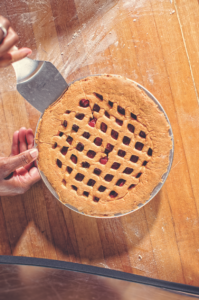 PARRIS’ GUAVA TART
PARRIS’ GUAVA TART
Makes: 1 tart (feeds 6 to 8 people)
For the dough:
- ¾ cup evaporated milk
- ¾ cup water
- ½ teaspoon salt
- 4 leveled cups + 1 tablespoon all-purpose flour
- 5 teaspoons baking powder
- 2 sticks unsalted butter
- 1 leveled cup + 2 tablespoons granulated sugar
- ½ teaspoon ground nutmeg
- ½ teaspoon ground cinnamon
- ½ teaspoon vanilla extract
- ½ teaspoon almond extract
- 1 large egg
 For the filling:
For the filling:
- 2 1-pound cans of guava shells
- 1 cinnamon stick
To make the filling:
- Combine milk, water and salt; set aside.
- Sift together flour and baking powder; set aside.
- Cream butter, sugar and spices until light and fluffy. Beat in egg. Gently fold flour into creamed mixture, alternating with liquids: start with flour, and end with flour ( flour, ½ liquid, flour, remaining liquid, remaining flour). Mix until just combined. Do not over mix.
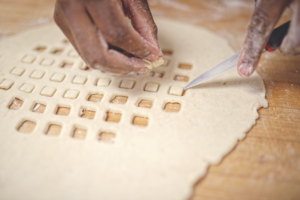 To prepare the dough:
To prepare the dough:
- Wrap dough in plastic wrap and let it rest in the fridge for four to six hours, or overnight. Store dough plastic-wrapped and placed in a zipper bag for up to a week in the refrigerator or eight weeks in the freezer.
To make the tart:
- Heat oven to 350 F.
- Heat guava shells and cinnamon stick over medium low heat, stirring often, until the juices reduce and slightly thicken. Remove from heat and let cool.
- Set oven rack in the middle of preheated oven. Lightly spray pie tin (8¾ inch by 1 inch).
- Portion out two 10-ounce pieces of dough. Roll one piece on a lightly floured surface, into a circle, about inch thick. Place in pie tin, allowing excess dough to hang over the edge.
- Fill the tart with guava. Roll second piece of dough into a circle, about inch thick, and cut ½ inch wide strips to make lattice top for tart. Press the top and bottom edges of dough together and cut excess dough from the edge of the tin.
- Place in oven for 40 minutes, rotating halfway through. Tart will be golden brown when finished. Can be stored at room temperature for up to three days.



